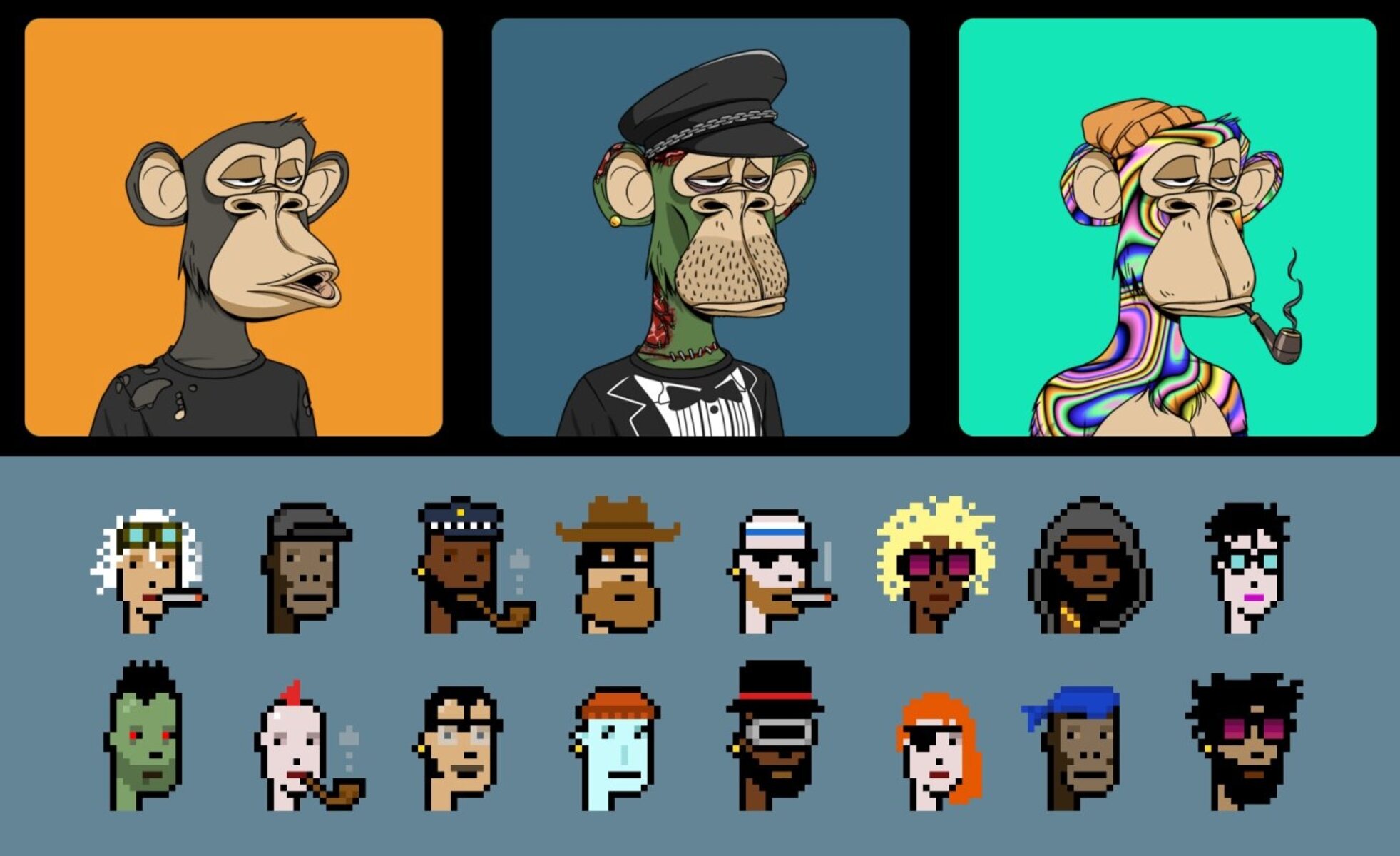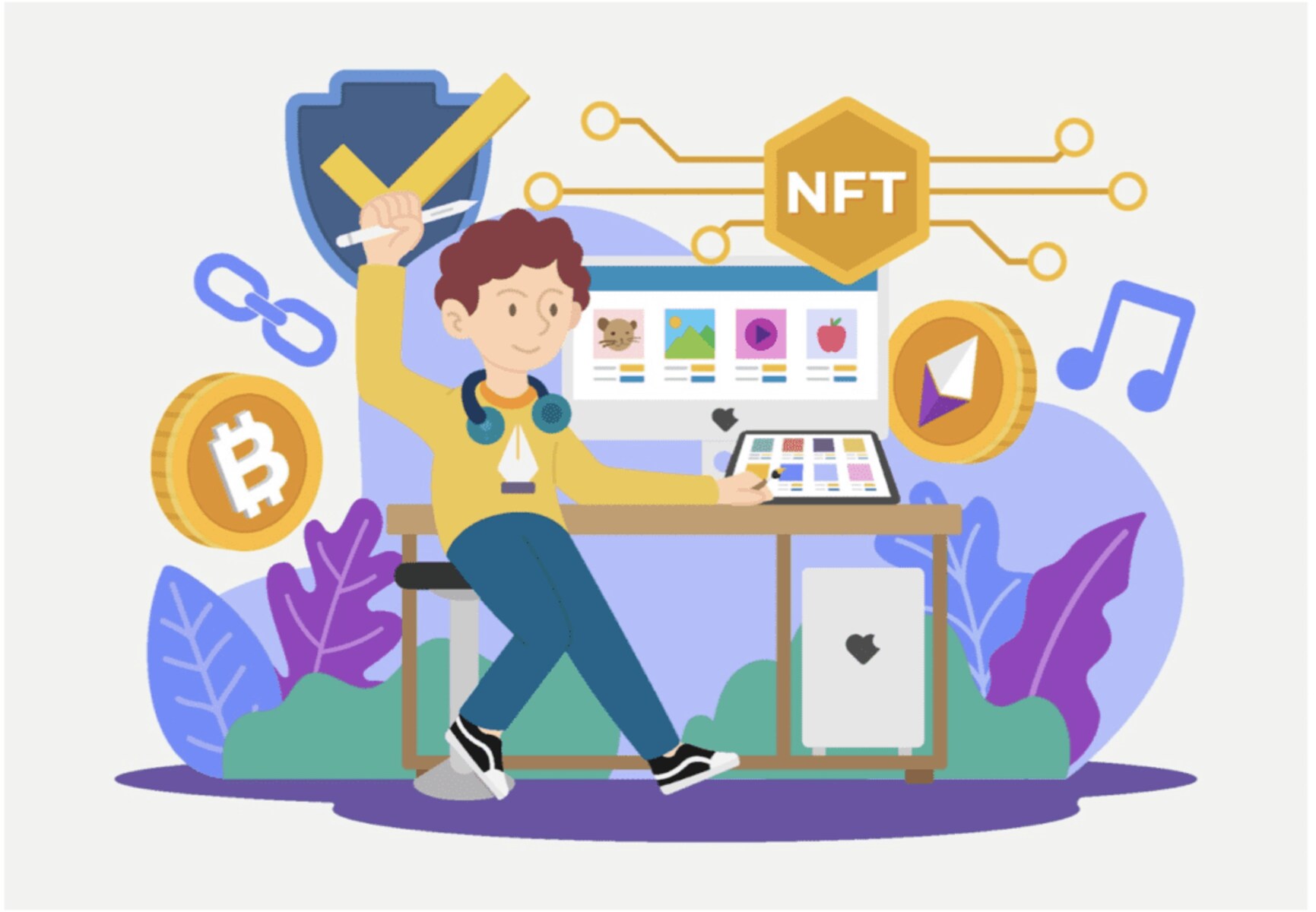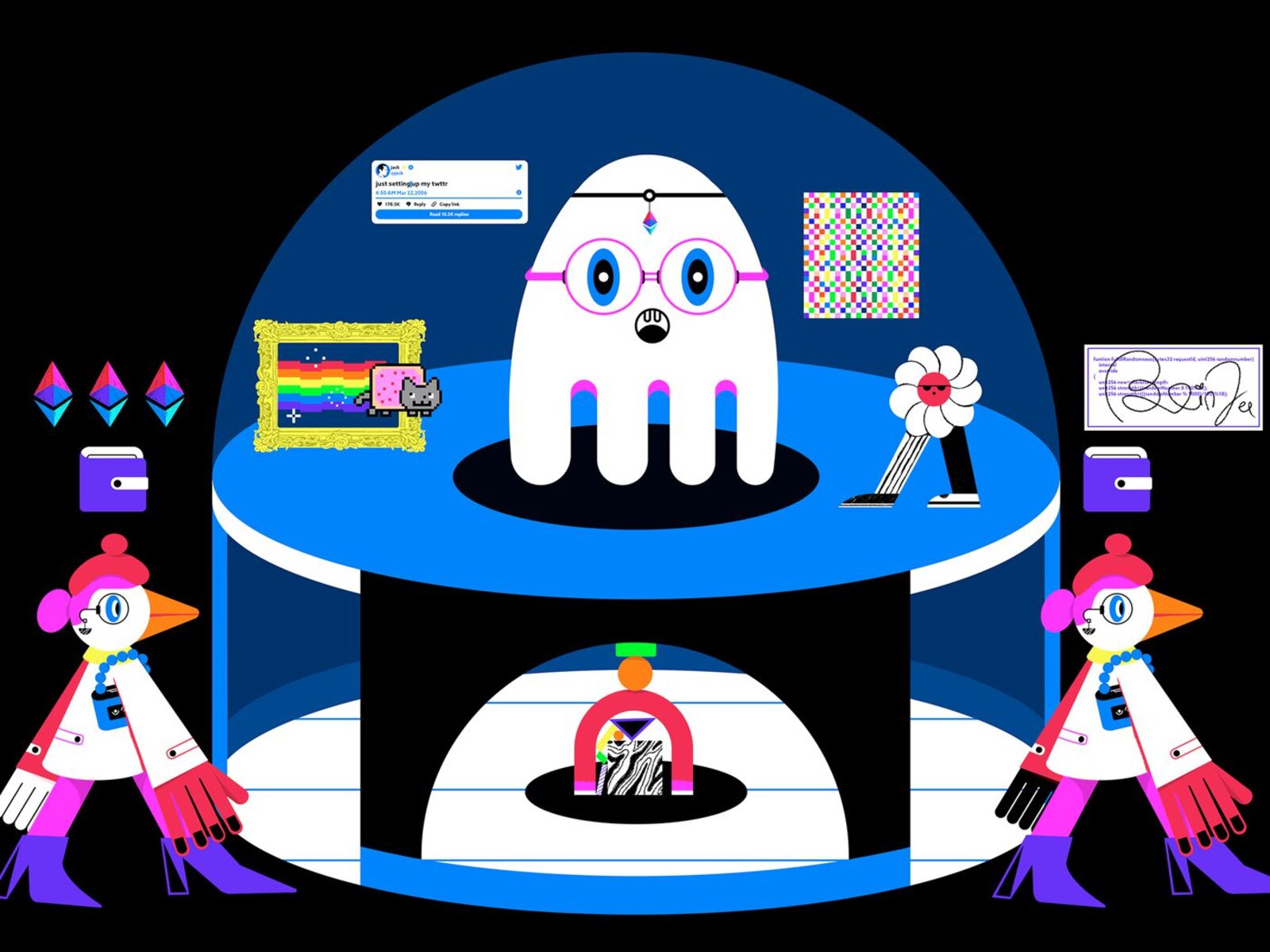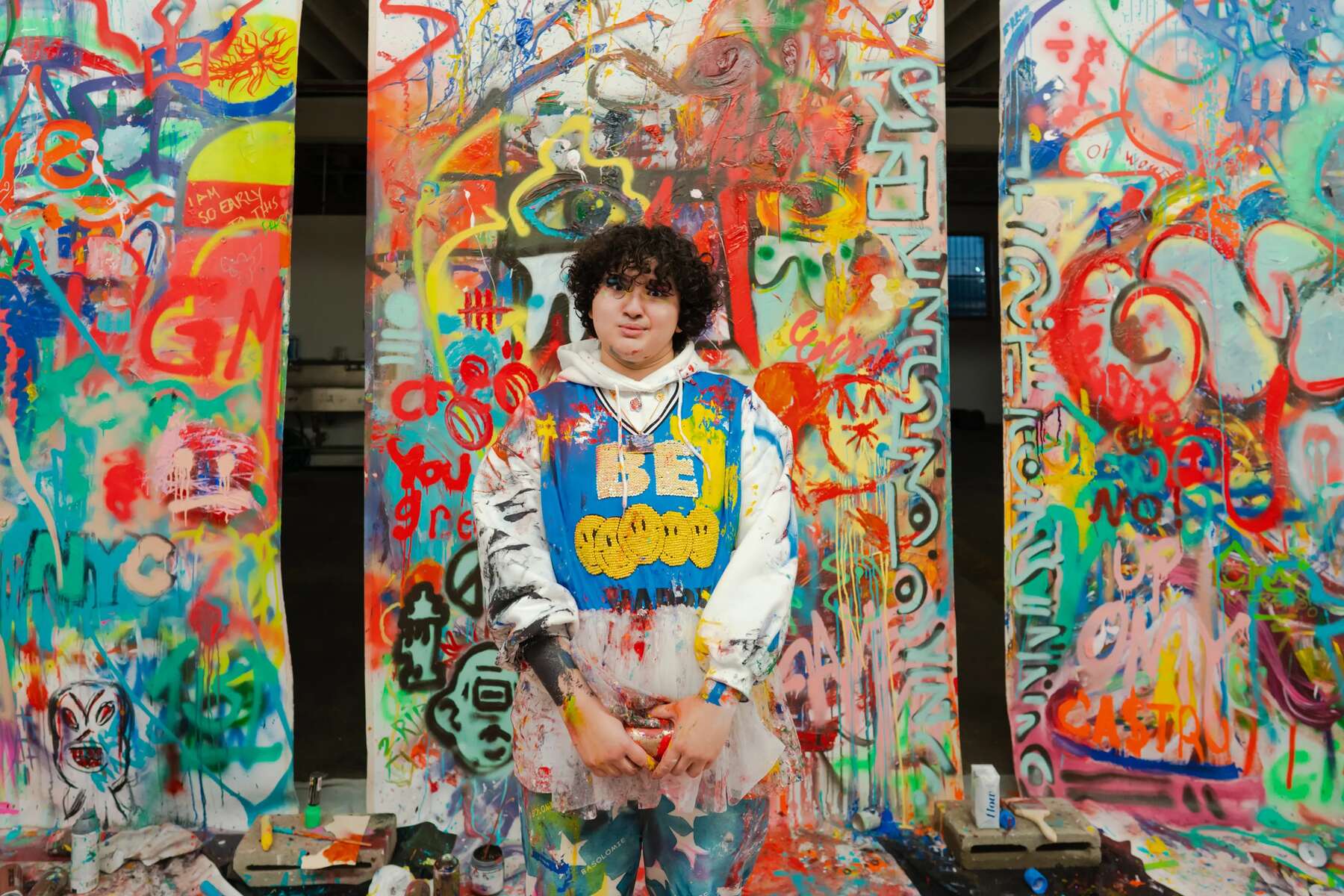Introduction
Welcome to the exciting world of NFTs! Non-Fungible Tokens (NFTs) have taken the digital world by storm, revolutionizing the way we buy, sell, and own digital assets. These unique and indivisible tokens have gained immense popularity, attracting artists, collectors, and investors from all corners of the globe.
With the rising demand for NFTs, many entrepreneurs and businesses are eager to get in on the action by building their own NFT marketplace. An NFT marketplace serves as a platform for creators to mint and sell their digital assets, while collectors can browse through a wide range of unique pieces and make purchases securely.
Building an NFT marketplace may seem like a daunting task, especially for those who are new to the world of blockchain technology. However, with the right knowledge and approach, you can turn your vision into reality and enter the exciting realm of digital art, collectibles, and more.
In this comprehensive guide, we will walk you through the key steps involved in building an NFT marketplace. From defining your objectives to launching and promoting your marketplace, we’ll cover everything you need to know to get started.
Whether you’re an artist looking to showcase and sell your work, a developer interested in blockchain technology, or an entrepreneur seeking new business opportunities, this guide will provide you with the necessary insights to embark on your NFT marketplace journey.
So, let’s dive in and explore the exciting possibilities that await you in the world of NFTs!
What is NFT?
NFT stands for Non-Fungible Token, which represents a unique digital asset or item that cannot be replaced or interchanged with anything else. Unlike cryptocurrencies such as Bitcoin or Ethereum, which are fungible and can be exchanged on a one-to-one basis, NFTs are one-of-a-kind and possess distinct properties and values.
Think of NFTs as digital certificates of authenticity that are stored on a blockchain. Each NFT contains metadata that defines its characteristics, ownership history, and other relevant information. This transparency and immutability make NFTs highly desirable and valuable in the digital world.
NFTs can represent various types of digital assets, including but not limited to:
- Artwork: NFTs have revolutionized the art industry, allowing artists to create and sell digital artwork with proven ownership and scarcity.
- Collectibles: NFTs have opened up a whole new market for digital collectibles, where people can buy and trade unique items like virtual trading cards, virtual pets, and more.
- Virtual Real Estate: With the rise of virtual worlds and metaverses, NFTs can be used to buy or sell virtual land or property within these digital realms.
- Music and Videos: Musicians and content creators can release exclusive tracks, albums, or videos as NFTs, providing fans with a special and unique experience.
- Domain Names: NFTs can also represent ownership of domain names in decentralized web systems, allowing individuals to buy and sell unique web addresses.
One of the key advantages of NFTs is the ability to prove ownership, provenance, and authenticity of digital assets. Blockchain technology ensures that ownership records are publicly verifiable, making it nearly impossible for counterfeit or unauthorized reproductions to exist.
Furthermore, the advent of NFTs has created new ways for artists and creators to monetize their work. With traditional art, the artist may only profit from the initial sale, but with NFTs, they can earn royalties each time their piece is resold on the secondary market. This has opened up substantial earning opportunities for creators.
Now that we have a clear understanding of what NFTs are and their potential applications, let’s delve into why building an NFT marketplace can be a lucrative venture in today’s digital landscape.
Why build an NFT marketplace?
The rise of NFTs has created a booming marketplace for digital assets, and building an NFT marketplace can offer numerous benefits and opportunities. Let’s explore some compelling reasons to embark on this venture:
1. Tap into the growing demand: NFTs have captured the attention of artists, collectors, and investors worldwide. Building an NFT marketplace allows you to cater to this growing demand and provide a platform for artists to showcase their work and collectors to discover and acquire unique digital assets.
2. Empower creators: NFT marketplaces empower artists and creators by allowing them to monetize their digital work in new and exciting ways. By building a marketplace, you can provide a space for creators to showcase and sell their art, music, videos, or any other digital asset they create, while retaining more control and earning potential compared to traditional distribution channels.
3. Foster a community: NFT marketplaces have the potential to foster vibrant communities of artists, collectors, and enthusiasts. By creating an interactive and engaging platform, you can facilitate connections, collaborations, and discussions among community members, driving engagement and loyalty.
4. Generate revenue: NFT marketplaces typically operate on a commission-based model, earning revenue from each transaction that takes place on the platform. As the marketplace grows and attracts a larger user base, the potential for generating substantial revenue increases. Additionally, some marketplaces offer premium features or services that can create additional revenue streams.
5. Pioneer innovation: Building an NFT marketplace allows you to be at the forefront of technological innovation. The convergence of blockchain technology, digital assets, and decentralized finance presents endless possibilities for creative experimentation and pushing the boundaries of what is possible in the world of digital ownership and value exchange.
6. Participate in a global movement: The NFT ecosystem has become a global phenomenon, attracting attention from mainstream media, investors, and celebrities. By building an NFT marketplace, you join an inclusive and dynamic community shaping the future of digital ownership and revolutionizing the art, entertainment, and gaming industries.
Overall, building an NFT marketplace can be a rewarding endeavor that combines passion, entrepreneurship, and technology. It allows you to contribute to the growth of the NFT ecosystem, empower creators, and create new ways for individuals to own and engage with digital assets. The possibilities are endless, and with the right approach and vision, your NFT marketplace can become a thriving hub for digital creativity and commerce.
Basic requirements for building an NFT marketplace
Building an NFT marketplace requires careful planning and consideration of various technical and operational requirements. Here are some of the basic elements you need to address:
1. Blockchain platform: Choose a suitable blockchain platform that supports NFT creation and trading. Ethereum is currently the most popular choice due to its robust smart contract capabilities and established ecosystem. However, other blockchain platforms like Binance Smart Chain and Flow also offer NFT functionality.
2. Smart contract standard: Select a smart contract standard for creating and managing NFTs on the chosen blockchain platform. Ethereum’s ERC-721 and ERC-1155 are widely used standards for NFTs, each with its own features and use cases. Research and choose the standard that best aligns with your marketplace’s requirements.
3. User interface and experience: Design an intuitive, user-friendly interface for your marketplace. Consider aspects such as easy navigation, seamless browsing of NFT collections, and a smooth buying and selling process. A visually appealing and responsive design can greatly enhance the user experience and attract more users to your platform.
4. Smart contract development: Develop the smart contracts that will power the minting, listing, and trading of NFTs on your marketplace. The smart contract should handle functions like token creation, ownership transfers, royalty distributions, and marketplace fees. Ensure thorough testing and auditing of your smart contracts to mitigate security risks.
5. Backend infrastructure: Implement a robust backend infrastructure to support the storage and retrieval of NFT metadata, such as images, descriptions, and attributes. This infrastructure should be scalable and capable of handling increasing amounts of data as your marketplace grows.
6. Blockchain wallet integration: Integrate blockchain wallet functionality to allow users to connect their wallets and securely manage their NFT collections. This integration ensures that users have full control over their assets and can easily participate in trading and transferring NFTs on your marketplace.
7. Security measures: Implement rigorous security measures to protect your marketplace and users’ assets from potential hacks or vulnerabilities. Use secure coding practices, conduct security audits, and consider implementing multi-factor authentication and encryption techniques to enhance the overall security of your platform.
8. Testing and deployment: Thoroughly test your marketplace functionality, including features like NFT minting, listing, buying, selling, and wallet integrations. Conduct user acceptance testing to identify and address any usability or technical issues. Once you are confident in the stability and functionality of your marketplace, deploy it to the live environment.
9. Marketing and customer support: Develop a comprehensive marketing strategy to promote your NFT marketplace and attract artists, collectors, and users. Leverage social media, influencers, and targeted advertising to reach your target audience. Additionally, provide reliable customer support to assist users with any inquiries or issues they may encounter.
By addressing these basic requirements, you can lay a solid foundation for your NFT marketplace. It is essential to continually improve and update your platform based on user feedback and market trends to stay competitive in the ever-evolving NFT landscape.
Step-by-step guide to building an NFT marketplace
Building an NFT marketplace requires careful planning and execution. Here is a step-by-step guide to help you navigate the process:
- Define your objectives and target audience: Determine the purpose of your marketplace and identify your target audience. Are you focusing on a specific niche or catering to a broader audience?
- Choose the blockchain platform: Select a blockchain platform that supports NFT functionality. Ethereum is a popular choice, but consider other platforms like Binance Smart Chain or Flow based on your specific needs.
- Select the smart contract standard: Choose a smart contract standard for NFT creation and management. Ethereum’s ERC-721 and ERC-1155 are widely used standards, each offering unique features.
- Design user interface and experience: Create an intuitive and visually appealing user interface. Consider aspects like easy navigation, clear artwork presentation, and a seamless buying and selling process.
- Develop the smart contract: Write and deploy the smart contracts that will power your marketplace. Implement functions such as NFT minting, ownership transfers, royalty distributions, and marketplace fees.
- Implement the backend infrastructure: Set up a scalable backend infrastructure to store and retrieve NFT metadata, such as images and descriptions. Ensure efficient and reliable data storage and retrieval processes.
- Integrate blockchain wallet functionality: Allow users to connect their blockchain wallets and securely manage their NFT collections. Implement wallet integration to enable seamless trading and transferring of NFTs.
- Test and secure the marketplace: Conduct thorough testing of the marketplace’s functionality and security measures. Test features like NFT minting, listing, buying, and selling, and ensure that appropriate security measures are in place to protect user assets.
- Launch and promote the NFT marketplace: Once you are confident in the stability and functionality of your marketplace, deploy it to the live environment. Develop a marketing strategy to promote your marketplace and attract artists and collectors. Leverage social media, influencers, and targeted advertising to reach your target audience.
Remember that building an NFT marketplace is an ongoing process. Continuously gather user feedback, iterate on the platform, and stay updated with the latest trends and developments in the NFT space to ensure your marketplace remains relevant and competitive.
Define your objectives and target audience
Before embarking on the journey of building an NFT marketplace, it is crucial to define your objectives and identify your target audience. This initial step sets the foundation for your marketplace and determines its direction. Here are some key considerations:
Objectives:
Clearly define the purpose and goals of your NFT marketplace. Ask yourself questions such as:
- Are you creating a platform to empower artists and help them monetize their digital creations?
- Are you aiming to provide a marketplace for collectors to discover and acquire unique digital assets?
- Are you interested in exploring new applications of NFTs beyond art, such as virtual real estate or domain names?
By establishing your objectives, you can align your development efforts, marketing strategies, and user experience design to cater to specific goals.
Target Audience:
Identifying your target audience is crucial for effective marketing and user acquisition. Consider the following aspects:
- Artists and creators: If your marketplace aims to empower artists, focus on attracting creators who want to showcase and sell their digital artwork. Provide features that support artists, such as customizable profiles, royalty mechanisms, and the ability to showcase their creative process.
- Collectors and investors: If your marketplace targets collectors and investors, emphasize the discovery and acquisition of unique digital assets. Provide a diverse range of NFTs, curated collections, and features that make it easy to browse and search for specific types of digital assets.
- Technologically inclined users: Some individuals are attracted to the technological aspect of blockchain and NFTs. For this audience, focus on emphasizing the underlying technology, security measures, and decentralization properties of your marketplace.
- Niche communities: Consider catering to specific niche communities within the broader NFT ecosystem. For example, you could create a marketplace specifically for digital artists, musicians, or gamers, providing tailored features and experiences that align with their interests and needs.
Understanding your target audience enables you to tailor your marketplace’s features, design, and marketing strategies to cater to their preferences, increasing the chances of engagement and adoption.
When defining your objectives and identifying your target audience, consider conducting market research, analyzing industry trends, and identifying gaps or opportunities in the existing NFT marketplace landscape. This research will help you position your marketplace uniquely and differentiate it from competitors.
By clearly defining your objectives and understanding your target audience, you can lay a solid foundation for your NFT marketplace and ensure that your development efforts align with the needs and aspirations of your users.
Choose the blockchain platform
Choosing the right blockchain platform is a critical decision when building an NFT marketplace. The blockchain platform you select will determine the functionality, scalability, and compatibility of your marketplace. Here are some factors to consider when making this decision:
1. Ethereum:
Ethereum is the most popular blockchain platform for NFTs due to its robust smart contract capabilities and established ecosystem. The majority of existing NFT marketplaces are built on Ethereum, offering a wide range of tools and resources for developers. However, it’s important to note that Ethereum’s network congestion and high transaction fees can be challenges to consider.
2. Binance Smart Chain (BSC):
Binance Smart Chain is an alternative blockchain platform that has gained popularity for its lower transaction fees and faster transaction confirmations compared to Ethereum. BSC provides compatibility with the Ethereum Virtual Machine (EVM), making it relatively easy to migrate or deploy Ethereum-based NFT contracts on BSC. Choosing BSC can be advantageous if you want to offer a more cost-effective experience for users.
3. Flow:
Flow is a blockchain platform specifically designed for NFTs and gaming applications. It offers a unique approach to scalability, allowing for high throughput and low transaction fees. Flow aims to provide a smooth user experience for NFT trading and gaming interactions. If your marketplace focuses on gaming or large-scale NFT trading, Flow could be a suitable choice.
4. Other blockchain platforms:
Aside from Ethereum, BSC, and Flow, there are other blockchain platforms that support NFT functionality. For example, Polygon (formerly Matic) is a Layer 2 solution built on Ethereum that offers faster and cheaper transactions. Tezos, EOS, and Tron are also blockchain platforms that have NFT capabilities. Consider these platforms if they align with your specific requirements and provide the infrastructure and ecosystem you need.
When choosing a blockchain platform, consider factors such as:
- Scalability: Assess the platform’s scalability capabilities to handle a large number of transactions and users.
- Developer community and resources: Evaluate the availability of developer tools, documentation, and community support for your chosen platform.
- Interoperability: Determine if the platform allows for interoperability with other blockchain networks, which can provide connectivity and accessibility for users.
- Transaction fees: Consider the cost of transactions on the chosen platform and how it will impact the user experience and the economics of your marketplace.
- Security and decentralization: Assess the security features, consensus mechanisms, and level of decentralization provided by the platform.
Ultimately, the choice of blockchain platform will depend on your specific needs, priorities, and the type of user experience you want to deliver. Conduct thorough research, analyze the pros and cons of each platform, and consider consulting with blockchain experts to make an informed decision.
Select the smart contract standard
Selecting the appropriate smart contract standard is a crucial step when building an NFT marketplace. The smart contract standard determines the rules and functionalities of the NFTs on your platform. Here are some common standards to consider:
1. ERC-721:
ERC-721 is one of the most widely adopted smart contract standards for NFTs on the Ethereum blockchain. Each ERC-721 token represents a unique, non-fungible item, such as digital artwork or collectibles. ERC-721 allows for individual ownership, transferability, and metadata storage for each token, making it ideal for creating and trading unique digital assets.
2. ERC-1155:
ERC-1155 is another popular smart contract standard on Ethereum. It allows for both fungible (identical and interchangeable) and non-fungible tokens to coexist within a single contract. This versatile standard is commonly used for gaming, where it enables the creation and management of various items, including weapons, armor, and collectibles. ERC-1155 can offer efficiency and cost savings by reducing the gas fees associated with deploying multiple contracts for different assets.
3. Alternative Standards:
While ERC-721 and ERC-1155 are the most widely recognized standards, there are other options available. For example, TRC-721 and TRC-1155 are the TRON blockchain equivalents of ERC-721 and ERC-1155, respectively. These alternative standards can be utilized if you decide to build your NFT marketplace on a different blockchain platform.
Factors to consider:
When selecting a smart contract standard, consider the following factors:
- Functionality: Evaluate the features and capabilities offered by each standard. Determine which standard aligns best with the specific nature of the digital assets you plan to host on your marketplace.
- Interoperability: Consider the interoperability of the chosen standard with other platforms and standards. This can enable cross-chain compatibility or collaboration opportunities in the future.
- Community and ecosystem: Assess the support, documentation, and tooling available for each standard. A robust community and developer ecosystem can provide valuable resources and assistance as you develop and maintain your marketplace.
- Gas fees: Gas fees on the blockchain affect the cost of executing smart contracts. Research how each standard handles gas fees and consider the implications for users who will interact with your marketplace.
- Standard adoption: Consider the prevalence and acceptance of each standard within the NFT ecosystem. Widespread adoption can simplify integration with other platforms and attract more developers and users to your marketplace.
It’s important to thoroughly understand the selected smart contract standard and its associated implications. Ensure that your chosen standard aligns with the goals and requirements of your NFT marketplace, allowing for seamless creation, trading, and management of digital assets on your platform.
Design user interface and experience
The user interface (UI) and experience (UX) of your NFT marketplace play a crucial role in attracting and retaining users. A well-designed and intuitive interface enhances engagement and encourages users to explore, buy, and sell digital assets on your platform. Here are key considerations for designing a compelling user interface and experience:
1. Intuitive navigation:
Create a clean and intuitive navigation structure that allows users to easily browse and search for NFTs. Implement logical categorization, filters, and sorting options to help users find specific assets or discover new ones. Consider providing different views such as grid, list, or gallery to cater to different user preferences.
2. Visual appeal:
Aesthetics are essential for capturing and retaining users’ attention. Use visually appealing designs, layout, and colors to create an engaging and inviting atmosphere. Showcase high-quality previews of NFTs to entice users and give them a glimpse of the digital assets they can acquire.
3. Smooth buying and selling process:
Simplify the process of buying and selling NFTs on your marketplace. Provide clear instructions for listing and pricing NFTs, and streamline the transaction process, including payment options and secure escrow services. Minimize friction points and ensure a smooth, user-friendly flow from start to finish.
4. Mobile-friendly design:
An increasing number of users access the internet through mobile devices. Optimize your marketplace for mobile devices by employing responsive design principles. Ensure that the user experience is seamless across different screen sizes, providing a consistent and enjoyable experience for mobile users.
5. User profile customization:
Allow users to personalize their profiles and provide information about themselves and their collections. Enable users to showcase their NFTs, update a profile picture, and add a bio. Providing these customization options creates a sense of ownership and identity within your marketplace.
6. Social and community features:
Encourage interaction and community building within your marketplace. Implement features such as comments, likes, and sharing options for NFTs. Consider integrating social media tools to allow users to share their favorite artworks and collections outside the marketplace, attracting new users to your platform.
7. Clear and concise information:
Display relevant information about each NFT, such as title, description, artist details, rarity, and edition number. Provide information on the history of ownership and any additional value or benefits associated with the asset. Clear and concise information helps users make informed decisions and builds trust in your marketplace.
8. User onboarding and support:
Ensure a smooth onboarding experience for new users by providing clear instructions and guidance. Offer user support channels, such as FAQs, tutorials, and responsive customer service, to assist users with any queries or issues they may encounter. This will instill confidence in your marketplace and help users feel supported throughout their journey.
Designing a user-friendly and visually appealing interface is an ongoing process. Continuously gather user feedback, conduct usability tests, and iterate on your design to improve the user experience and meet evolving user expectations. Strive to create an interface that delights and engages your users, making them return to your marketplace for their NFT needs.
Develop the smart contract
The smart contract is the backbone of your NFT marketplace, governing the creation, ownership, and trading of digital assets. Developing a robust and secure smart contract is crucial to ensure the smooth functioning of your marketplace. Here are key steps to consider when developing the smart contract:
1. Define the functionalities:
Clearly outline the functionalities and features you want your smart contract to support. This includes aspects such as NFT creation, ownership transfers, royalty distributions, and marketplace fees. Determine the rules and logic that will govern the behavior of your NFTs on the marketplace.
2. Choose a programming language:
Select a programming language that is compatible with your chosen blockchain platform and smart contract standard. For Ethereum-based contracts, Solidity is commonly used, while Vyper is an alternative language known for its security-focused design. Ensure that you have a good understanding of the chosen programming language to write clean and efficient code.
3. Implement NFT creation:
Develop the functionality to allow users to create and mint new NFTs. Define the required attributes for each NFT, such as title, description, image, and any additional metadata. Ensure uniqueness and enforce any restrictions or limitations you want to impose on the creation process.
4. Handle ownership transfers:
Implement the logic to handle the transfer of NFT ownership from one user to another. This includes verifying the authenticity and availability of the NFTs, updating ownership records, and ensuring secure and transparent transactions.
5. Royalty distributions:
If you want to include royalty distributions for creators, design the smart contract to handle the automatic transfer of royalties whenever an NFT is resold on the secondary market. Determine the percentage of royalties and establish the mechanisms to distribute them to the original creator or token rights holders.
6. Marketplace fees:
If your marketplace charges fees for transactions, implement the functionality to calculate and collect these fees. Determine the fee structure, whether it is a fixed amount or a percentage of the transaction volume, and ensure transparent and fair fee collection that aligns with your marketplace’s terms and conditions.
7. Security and testing:
Security is paramount when developing a smart contract. Conduct comprehensive security audits and testing to identify and address any vulnerabilities or potential exploits. Follow best practices for secure coding, such as input sanitization, access control, and proper handling of external contracts or libraries.
8. Deployment and upgrades:
After thorough testing and auditing, deploy the smart contract to the blockchain. Ensure that you have a well-defined deployment strategy that includes proper testing in the intended environment. Consider future upgrades and plan for smart contract upgradability, allowing you to introduce new features or fix any issues without disrupting the live marketplace.
9. Documentation and transparency:
Create clear and comprehensive documentation for your smart contract to facilitate future maintenance and collaborations with other developers. Make your smart contract code publicly available and engage with the developer community to garner feedback and improve the contract’s security and functionality.
Developing a smart contract requires expertise in blockchain technology and programming. If you are not proficient in smart contract development, consider seeking assistance from experienced blockchain developers or auditors to ensure the security and proper functioning of your smart contract.
Implement the backend infrastructure
Implementing a robust backend infrastructure is crucial for the successful operation of your NFT marketplace. The backend infrastructure encompasses the various systems and components that facilitate the storage, retrieval, and management of data related to NFTs and user interactions. Here are essential steps to consider when implementing the backend infrastructure:
1. Data storage:
Choose a reliable and scalable storage solution for storing NFT metadata, such as images, descriptions, and additional attributes. Consider using distributed storage systems or decentralized file storage protocols to ensure data redundancy, availability, and resilience.
2. Database management:
Implement a database management system to efficiently store and retrieve relevant data for NFTs, user profiles, transactions, and other marketplace-related information. Design database schemas and relationships that allow for easy querying and data manipulation.
3. File hosting:
Ensure a seamless hosting solution for storing and serving NFT images and other media files associated with your marketplace. Consider leveraging content delivery networks (CDNs) to optimize the delivery and performance of media assets, reducing latency and improving the user experience.
4. API development:
Develop application programming interfaces (APIs) that serve as the communication interface between the frontend of your marketplace and the backend systems. APIs enable seamless integration with different components, such as smart contracts, databases, and external services, allowing for efficient data exchange and functionality execution.
5. Data security:
Implement stringent security measures to protect sensitive data and user information. Enforce secure communication protocols, encryption, access controls, and data backup and recovery mechanisms. Regularly monitor and audit security measures to identify and address potential vulnerabilities.
6. Scalability and performance:
Design the backend infrastructure with scalability in mind to accommodate a growing user base and increasing transaction volume. Consider using distributed systems and load balancing techniques to improve performance and handle high levels of concurrent requests and data processing.
7. Analytics and reporting:
Implement analytics and reporting capabilities to gain valuable insights into user behavior, marketplace performance, and asset trends. This information can help inform decision-making, optimize marketing strategies, and enhance the overall user experience of your NFT marketplace.
8. Continuous monitoring and maintenance:
Regularly monitor and maintain the backend infrastructure to ensure optimal performance, reliability, and data integrity. Proactively identify and address any issues or bottlenecks to minimize downtime and maximize user satisfaction.
It is essential to work with experienced backend developers and infrastructure engineers to implement a robust and efficient backend infrastructure. Collaborate closely with your development team to ensure seamless integration between the frontend user interface and the backend systems, ensuring a cohesive and seamless user experience in your NFT marketplace.
Integrate blockchain wallet functionality
Integrating blockchain wallet functionality is a vital aspect of building an NFT marketplace. Blockchain wallets allow users to securely manage their digital assets, interact with smart contracts, and participate in trading activities. Here are key considerations when integrating blockchain wallet functionality into your marketplace:
1. Choose a compatible wallet:
Select a blockchain wallet that is compatible with the blockchain platform and smart contract standard you have chosen for your NFT marketplace. Popular options include MetaMask, Trust Wallet, and WalletConnect. Consider factors such as ease of use, security features, and the wallet’s compatibility with the browsers and devices your target audience is likely to use.
2. User wallet onboarding:
Provide clear instructions and guidance for users to set up and connect their blockchain wallets to your marketplace. Include step-by-step tutorials, tooltips, or pop-up messages to assist users throughout the wallet onboarding process. This helps ensure a smooth and seamless experience for users who may be new to blockchain technology.
3. Asset visibility and management:
Enable users to view and manage their NFT assets directly from within the wallet interface. Display a comprehensive list or gallery view of their NFT collection, including relevant information such as title, image, owner, and any associated metadata. Implement features such as sorting, filtering, and search functionality to enhance asset discoverability and organization.
4. Secure asset transfers:
Integrate functionality that allows users to initiate secure transfers of their NFTs to other wallet addresses. Implement proper authentication mechanisms, confirmation prompts, and transaction signing to ensure that asset transfers are executed securely and accurately.
5. Wallet connectivity with smart contracts:
Establish connectivity between the blockchain wallet and the smart contracts powering your NFT marketplace. This allows users to interact with the smart contracts for actions such as listing NFTs for sale, placing bids on NFTs, or accepting offers. Implement secure communication protocols and follow best practices for interacting with blockchain networks.
6. Transaction history and notifications:
Provide users with a transaction history log within their wallets, allowing them to review past activities such as purchases, sales, and bids. Implement real-time notifications to keep users informed of important events, such as bid activities, successful purchases, or new offers received.
7. Multi-chain and cross-chain compatibility:
Consider supporting multiple blockchain networks or cross-chain compatibility if your NFT marketplace intends to expand beyond a single blockchain platform. This allows users to connect different wallets from various blockchains and seamlessly interact with NFTs across different networks.
8. Security and privacy:
Prioritize the security and privacy of users’ wallet information and transactions. Implement encryption and authentication measures to safeguard user accounts and private keys. Advise users on best practices for wallet security, such as storing private keys in secure hardware wallets or using biometric authentication.
Integrating blockchain wallet functionality enhances user engagement and fosters trust in your NFT marketplace. Collaborate with experienced developers familiar with blockchain wallet integration to ensure a seamless experience and reliable connectivity between your marketplace and users’ wallets.
Test and secure the marketplace
Thorough testing and stringent security measures are essential to ensure the stability, reliability, and safety of your NFT marketplace. Here are key steps to effectively test and secure your marketplace:
1. Functional testing:
Conduct comprehensive functional testing to verify that all features and functionalities of your marketplace are working as intended. Test scenarios such as NFT creation, listing, buying, selling, and transfer of ownership to ensure smooth and error-free user interactions.
2. User acceptance testing:
Invite selected users or a group of beta testers to assess your marketplace’s usability and gather valuable feedback. Pay attention to their experience, solicit their input on potential improvements, and address any issues or concerns identified during this testing phase.
3. Performance testing:
Simulate heavy user traffic and stress test your marketplace to ensure it can handle a high volume of concurrent users and transactions without performance degradation. Monitor response times, assess scalability, and optimize bottlenecks to ensure a seamless user experience, even during peak usage periods.
4. Security audits:
Engage with third-party security auditors or experts to conduct penetration testing and security audits of your marketplace. They will help identify vulnerabilities and potential attack vectors, such as unauthorized access, data breaches, or smart contract vulnerabilities. Address any vulnerabilities and apply recommended security patches to enhance the overall security posture of your marketplace.
5. Encryption and data protection:
Implement encryption mechanisms to protect sensitive user data, such as personal information, wallet addresses, and transaction details. Follow best practices for data encryption both in transit and at rest. Encrypt communication channels and ensure secure storage of data to prevent unauthorized access.
6. Account security and access controls:
Adopt strict access controls to safeguard user accounts and prevent unauthorized access. Implement strong password policies, multi-factor authentication, and session management mechanisms. Educate users about best practices for securing their accounts, such as using strong passwords and enabling two-factor authentication.
7. Regular updates and patches:
Stay up-to-date with security patches and updates for the software and libraries used in your marketplace. Continuously monitor vulnerabilities and security advisories to ensure your marketplace is protected against any known security issues. Regularly apply updates to mitigate emerging threats and maintain a secure environment.
8. Incident response plan:
Develop an incident response plan that outlines the steps to be taken in the event of a security breach or system failure. Prepare for contingencies by backing up data, establishing backup and recovery procedures, and conducting periodic disaster recovery drills.
9. Compliance with regulations:
Ensure your marketplace complies with applicable laws and regulations, such as data protection and privacy laws. Make users aware of your privacy policy and how you handle their personal information. Consult legal experts to ensure your marketplace’s operations align with the relevant legal requirements.
By conducting rigorous testing and implementing robust security measures, you can provide a safe and reliable platform for users to engage with NFTs on your marketplace. Prioritize user trust and maintain a proactive stance towards security and compliance to safeguard users’ assets and personal information.
Launch and promote the NFT marketplace
After completing the development and testing phases of your NFT marketplace, it’s time to launch your platform and attract users to engage with your digital assets. Here are crucial steps to consider when launching and promoting your NFT marketplace:
1. Set a launch strategy:
Create a detailed launch plan that encompasses various aspects, such as target launch date, marketing strategies, community engagement, and user onboarding. Define specific goals and objectives to guide your launch efforts.
2. Build a community:
Establish a community around your NFT marketplace by engaging with potential users, artists, collectors, and industry influencers. Leverage social media platforms, online forums, and dedicated communication channels to foster discussions, collaborations, and promotional activities.
3. Content creation and storytelling:
Create compelling and shareable content to showcase the unique aspects and value proposition of your NFT marketplace. Develop visually appealing graphics, videos, and blog posts that highlight featured artists, collections, or success stories. Craft a captivating brand story to resonate with your target audience.
4. Influencer collaborations:
Partner with influencers and key opinion leaders in the NFT community to amplify your visibility and reach. Collaborate with well-known artists, collectors, or industry experts who can promote your marketplace and endorse the value it offers to users.
5. Social media marketing:
Utilize social media platforms to create awareness and drive user engagement. Develop a strong presence on platforms like Twitter, Instagram, and Discord. Regularly share updates on new listings, artist interviews, and community events. Engage with followers, respond to comments, and encourage user-generated content.
6. Paid advertising:
Consider allocating a budget for paid advertising to target specific user segments and maximize your reach. Utilize targeted ads on platforms like Google Ads or social media platforms to capture the attention of potential users interested in NFTs and digital art.
7. Community partnerships:
Collaborate with other NFT marketplaces, art communities, or blockchain-related projects to expand your reach and tap into their existing user base. Explore opportunities for joint promotions, cross-listings, or strategic partnerships to leverage mutual growth and engagement.
8. User onboarding and support:
Ensure a seamless onboarding experience for new users. Provide clear instructions, intuitive interfaces, and responsive customer support to guide users through the process of creating an account, connecting their wallets, and exploring the marketplace. Empower users with the knowledge and resources to fully utilize your platform’s features.
9. Feedback collection and iteration:
Seek user feedback and actively listen to user suggestions and concerns. Continuously improve and iterate your marketplace based on user insights to enhance the user experience. Regularly release updates and new features to keep users engaged and excited about your platform.
10. Community events and collaborations:
Organize virtual events, webinars, or AMAs (Ask Me Anything) sessions to engage with your community and provide them with an opportunity to interact with artists, developers, or team members. Collaborate with artists to launch exclusive collections or host auctions to generate buzz and attract new users.
Launching and promoting an NFT marketplace requires proactive marketing efforts and community engagement. Continuously analyze your marketing strategies and adapt as needed to maximize user acquisition, retention, and overall marketplace growth.
Conclusion
Building an NFT marketplace requires careful planning, technical expertise, and a deep understanding of the evolving NFT landscape. By following the steps outlined in this guide, you can embark on a successful journey to create your own NFT marketplace.
From defining your objectives and identifying your target audience to selecting the blockchain platform and smart contract standard, each step is crucial in laying a strong foundation for your marketplace. Designing a user-friendly interface, developing secure smart contracts, and implementing a robust backend infrastructure are essential for delivering a seamless and engaging user experience.
Launching and promoting your marketplace requires a strategic approach, including building a strong community, creating compelling content, and collaborating with influencers and industry partners. Continuously monitor and iterate your marketplace based on user feedback, market trends, and emerging technologies to stay relevant and competitive.
It is important to recognize that the NFT landscape is constantly evolving. Stay up-to-date with industry news, regulatory changes, and emerging technologies to adapt and seize new opportunities as they arise. Engage with the vibrant NFT community, participate in discussions, and explore potential partnerships to foster growth and expand your marketplace’s reach.
Building an NFT marketplace offers an exciting opportunity to empower artists, collectors, and users in the digital realm. By leveraging blockchain technology, you can revolutionize digital ownership, enable new revenue streams, and create a thriving marketplace for unique and valuable digital assets.
Remember, success in the NFT space requires a combination of technical expertise, creative vision, strategic marketing, and a deep understanding of the needs and preferences of your target audience. Embrace the ever-evolving nature of the NFT ecosystem and be prepared to adapt your marketplace to meet the changing demands and expectations of users.
Go forth with passion and determination, and may your NFT marketplace become a hub of innovation, creativity, and meaningful digital connections.

























